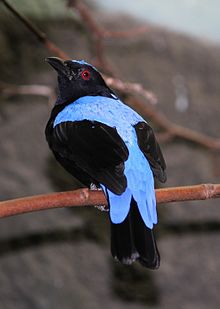| Fairy-bluebirds | |
|---|---|

| |
| Asian fairy-bluebird - male | |

| |
| female | |
| Scientific classification | |
| Domain: | Eukaryota |
| Kingdom: | Animalia |
| Phylum: | Chordata |
| Class: | Aves |
| Order: | Passeriformes |
| Suborder: | Passeri |
| Family: | Irenidae Jerdon, 1863 |
| Genus: | Irena Horsfield, 1821 |
| Type species | |
| Coracias puella[1] Latham, 1790
| |
| Species | |

| |
| Irena puella light green, Irena cyanogaster dark green, Irena tweeddalli not shown | |
The three fairy-bluebirds are small passerine bird species found in forests and plantations in tropical southern Asia and the Philippines. They are the sole members of the genus Irena and family Irenidae, and are related to the ioras and leafbirds.
These are bulbul-like birds of open forest or thorn scrub, but whereas that group tends to be drab in colouration, fairy-bluebirds are sexually dimorphic, with the males being dark blue in plumage, and the females duller green.
These species eat fruit, especially figs, and possibly some insects. They lay two to three eggs in a tree nest.
The call of the Asian fairy-bluebird is a liquid two note Glue-It.
As the names would suggest, the Asian fairy-bluebird (I. puella) occurs across southern Asia, the Philippine fairy-bluebird (I. cyanogastra) in that archipelago, and the Palawan fairy-bluebird (I. tweeddalii)[2] on the island of Palawan.
- ^ "Irenidae". aviansystematics.org. The Trust for Avian Systematics. Retrieved 2023-07-16.
- ^ "Species Updates – IOC World Bird List". Retrieved 2021-05-28.